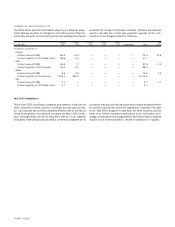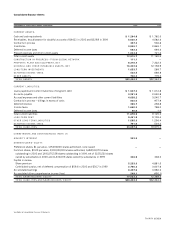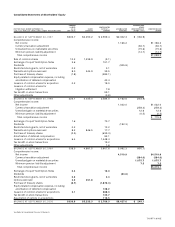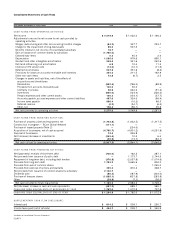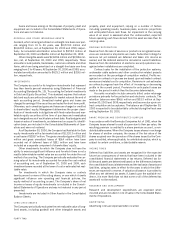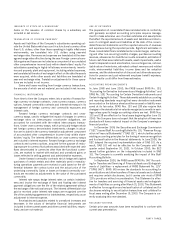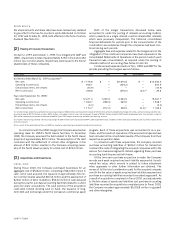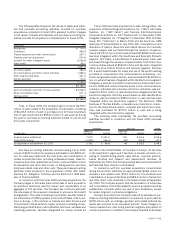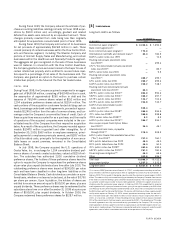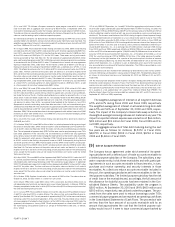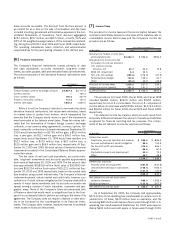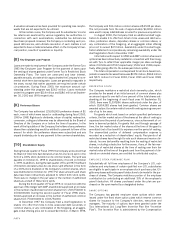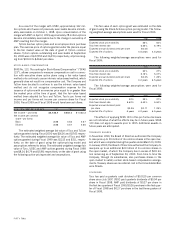ADT 2000 Annual Report Download - page 45
Download and view the complete annual report
Please find page 45 of the 2000 ADT annual report below. You can navigate through the pages in the report by either clicking on the pages listed below, or by using the keyword search tool below to find specific information within the annual report.
FORTY THREE
ISSUANCE OF STOCK BY A SUBSIDIARY
Gains on the issuance of common shares by a subsidiary are
included in net income.
TRANSLATION OF FOREIGN CURRENCY
Assets and liabilities of the Company’s subsidiaries operating out-
side the United States which account in a functional currency other
than U.S. dollars, other than those operating in highly inflationary
environments, are translated into U.S. dollars using year-end
exchange rates. Revenues and expenses are translated at the aver-
age exchange rates effective during the year. Foreign currency trans-
lation gains and losses are included as a component of accumulated
other comprehensive income (loss) within shareholders’ equity. For
subsidiaries operating in highly inflationary environments, invento-
ries and property, plant and equipment, including related expenses,
are translated at the rate of exchange in effect on the date the assets
were acquired, while other assets and liabilities are translated at
year-end exchange rates. Translation adjustments for these opera-
tions are included in net income.
Gains and losses resulting from foreign currency transactions,
the amounts of which are not material, are included in net income.
FINANCIAL INSTRUMENTS
From time to time the Company enters into a variety of forward for-
eign currency exchange contracts, cross-currency swaps, currency
options, forward commodity contracts and interest rate swaps in its
management of foreign currency and commodity exposures and
interest costs.
Forward foreign currency exchange contracts and cross-
currency swaps, used to mitigate the impact of changes in currency
exchange rates on intercompany cross-border obligations, are
accounted for consistent with the related intercompany transac-
tions. Under cross-currency swaps, which principally hedge certain
net foreign currency denominated investments, changes in valua-
tion are included in the currency translation adjustment component
of accumulated other comprehensive income (loss) within share-
holders’ equity. The interest differentials on cross-currency swaps
are included in interest expense. Forward foreign currency exchange
contracts and currency options, acquired for the purpose of reduc-
ing exposure to currency fluctuations associated with expected cash
flows denominated in currencies other than the functional curren-
cies, are marked to market with realized and unrealized gains or
losses reflected in selling, general and administrative expenses.
Under forward commodity contracts which hedge anticipated
purchases of certain metals and other materials used in manufac-
turing operations payments are received or paid based on the dif-
ferential between the contract price and the actual price of the
underlying commodity. Gains or losses on forward commodity con-
tracts are recorded as adjustments to the value of the purchased
commodity.
Interest rate swaps hedge interest rates on certain indebted-
ness and involve the exchange of fixed and floating rate interest
payment obligations over the life of the related agreement without
the exchange of the notional amount. The interest differentials to be
paid or received under interest rate swaps are recognized over the
life of the underlying agreement or indebtedness, respectively, as an
adjustment to interest expense.
Receivables and payables related to unrealized increases and
decreases in the values of derivative financial instruments are
included in other current assets and other current liabilities, respec-
tively, and are not material.
USE OF ESTIMATES
The preparation of consolidated financial statements in conformity
with generally accepted accounting principles requires manage-
ment to make extensive use of certain estimates and assumptions
that affect the reported amount of assets and liabilities and disclo-
sure of contingent assets and liabilities at the date of the consoli-
dated financial statements and the reported amounts of revenues
and expenses during the reported periods. Significant estimates in
these consolidated financial statements include merger, restructur-
ing and other non-recurring (credits) charges, purchase accounting
reserves, allowances for doubtful accounts receivable, estimates of
future cash flows associated with assets, asset impairments, useful
lives for depreciation and amortization, loss contingencies, net real-
izable value of inventories, estimated contract revenues and related
costs, environmental liabilities, income taxes and tax valuation
reserves, and the determination of discount and other rate assump-
tions for pension and post-retirement employee benefit expenses.
Actual results could differ from these estimates.
ACCOUNTING PRONOUNCEMENTS
In June 1998 and June 2000, the FASB issued SFAS No. 133,
“Accounting for Derivative Instruments and Hedging Activities” and
SFAS No. 138, “Accounting for Certain Derivative Instruments and
Certain Hedging Activities.” These statements establish accounting
and reporting standards requiring that every derivative instrument
be recorded on the balance sheet as either an asset or liability mea-
sured at its fair value. SFAS Nos. 133 and 138 also require that
changes in the derivative’s fair value be recognized currently in earn-
ings unless specific hedge accounting criteria are met. SFAS Nos.
133 and 138 are effective for fiscal years beginning after June 15,
2000. The Company does not expect that the adoption of these new
standards will have a material impact on the Company’s earnings or
financial position.
In December 1999, the Securities and Exchange Commission
(“SEC”) issued Staff Accounting Bulletin No. 101, “Revenue Recog-
nition in Financial Statements” (“SAB 101”), which clarifies certain
existing accounting principles for the timing of revenue recognition
and its classification in the financial statements. In June 2000, the
SEC delayed the required implementation date of SAB 101. As a
result, SAB 101 will not be effective for the Company until the
quarter ended September 30, 2001. In October 2000, the SEC
issued further guidance on the interpretations included in SAB
101. The Company is currently analyzing the impact of this Staff
Accounting Bulletin.
In September 2000, the FASB issued SFAS No. 140 “Account-
ing for Transfers and Servicing of Financial Assets and Extinguish-
ments of Liabilities—a replacement of FASB Statement No. 125”
(“SFAS 140”). SFAS 140 revises the standards for accounting for
securitizations and other transfers of financial assets and collateral
and requires certain disclosures, but it carries over most of SFAS
125’s provisions without reconsideration. This Statement is effec-
tive for transfers and servicing of financial assets and extinguish-
ments of liabilities occurring after March 31, 2001. This Statement
is effective for recognition and reclassification of collateral and for
disclosures relating to securitization transactions and collateral for
fiscal years ending after December 15, 2000. The Company is cur-
rently analyzing this new standard.
RECLASSIFICATIONS
Certain prior year amounts have been reclassified to conform with
current year presentation.



